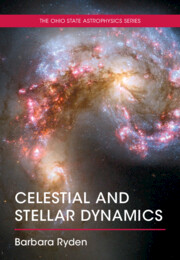Refine listing
Actions for selected content:
17002 results

Celestial and Stellar Dynamics
-
- Published online:
- 16 January 2025
- Print publication:
- 30 January 2025
-
- Textbook
- Export citation
1 - Are the Central Configurations Finite?
- from Part Two - The Questions
-
- Book:
- Four Open Questions for the <i>N</i>-Body Problem
- Published online:
- 12 December 2024
- Print publication:
- 19 December 2024, pp 75-100
-
- Chapter
- Export citation
Appendix E - Braids, Homotopy, and Homology
-
- Book:
- Four Open Questions for the <i>N</i>-Body Problem
- Published online:
- 12 December 2024
- Print publication:
- 19 December 2024, pp 264-266
-
- Chapter
- Export citation
Appendix C - The Three-Body Problem and the Shape Sphere
-
- Book:
- Four Open Questions for the <i>N</i>-Body Problem
- Published online:
- 12 December 2024
- Print publication:
- 19 December 2024, pp 242-261
-
- Chapter
- Export citation
2 - Are There Any Stable Periodic Orbits?
- from Part Two - The Questions
-
- Book:
- Four Open Questions for the <i>N</i>-Body Problem
- Published online:
- 12 December 2024
- Print publication:
- 19 December 2024, pp 101-137
-
- Chapter
- Export citation
Preface
-
- Book:
- Four Open Questions for the <i>N</i>-Body Problem
- Published online:
- 12 December 2024
- Print publication:
- 19 December 2024, pp xi-xiv
-
- Chapter
- Export citation
4 - Does a Scattered Beam Have a Dense Image?
- from Part Two - The Questions
-
- Book:
- Four Open Questions for the <i>N</i>-Body Problem
- Published online:
- 12 December 2024
- Print publication:
- 19 December 2024, pp 196-214
-
- Chapter
- Export citation
Appendix F - The Jacobi–Maupertuis Metric
-
- Book:
- Four Open Questions for the <i>N</i>-Body Problem
- Published online:
- 12 December 2024
- Print publication:
- 19 December 2024, pp 267-270
-
- Chapter
- Export citation
Part One - Tour, Problem, And Structures
-
- Book:
- Four Open Questions for the <i>N</i>-Body Problem
- Published online:
- 12 December 2024
- Print publication:
- 19 December 2024, pp 1-2
-
- Chapter
- Export citation
Frontmatter
-
- Book:
- Four Open Questions for the <i>N</i>-Body Problem
- Published online:
- 12 December 2024
- Print publication:
- 19 December 2024, pp i-iv
-
- Chapter
- Export citation
3 - Is Every Braid Realized?
- from Part Two - The Questions
-
- Book:
- Four Open Questions for the <i>N</i>-Body Problem
- Published online:
- 12 December 2024
- Print publication:
- 19 December 2024, pp 138-195
-
- Chapter
- Export citation
Appendix H - One Degree of Freedom and Central Scattering
-
- Book:
- Four Open Questions for the <i>N</i>-Body Problem
- Published online:
- 12 December 2024
- Print publication:
- 19 December 2024, pp 276-284
-
- Chapter
- Export citation
Contents
-
- Book:
- Four Open Questions for the <i>N</i>-Body Problem
- Published online:
- 12 December 2024
- Print publication:
- 19 December 2024, pp vii-x
-
- Chapter
- Export citation
References
-
- Book:
- Four Open Questions for the <i>N</i>-Body Problem
- Published online:
- 12 December 2024
- Print publication:
- 19 December 2024, pp 285-295
-
- Chapter
- Export citation
0 - The Problem and Its Structure
- from Part One - Tour, Problem, And Structures
-
- Book:
- Four Open Questions for the <i>N</i>-Body Problem
- Published online:
- 12 December 2024
- Print publication:
- 19 December 2024, pp 23-72
-
- Chapter
- Export citation
Appendices
-
- Book:
- Four Open Questions for the <i>N</i>-Body Problem
- Published online:
- 12 December 2024
- Print publication:
- 19 December 2024, pp 215-216
-
- Chapter
- Export citation
Dedication
-
- Book:
- Four Open Questions for the <i>N</i>-Body Problem
- Published online:
- 12 December 2024
- Print publication:
- 19 December 2024, pp v-vi
-
- Chapter
- Export citation
Index
-
- Book:
- Four Open Questions for the <i>N</i>-Body Problem
- Published online:
- 12 December 2024
- Print publication:
- 19 December 2024, pp 296-298
-
- Chapter
- Export citation
-1 - A Tour of Solutions
- from Part One - Tour, Problem, And Structures
-
- Book:
- Four Open Questions for the <i>N</i>-Body Problem
- Published online:
- 12 December 2024
- Print publication:
- 19 December 2024, pp 3-22
-
- Chapter
- Export citation
Appendix G - Regularizing Binary Collisions
-
- Book:
- Four Open Questions for the <i>N</i>-Body Problem
- Published online:
- 12 December 2024
- Print publication:
- 19 December 2024, pp 271-275
-
- Chapter
- Export citation
